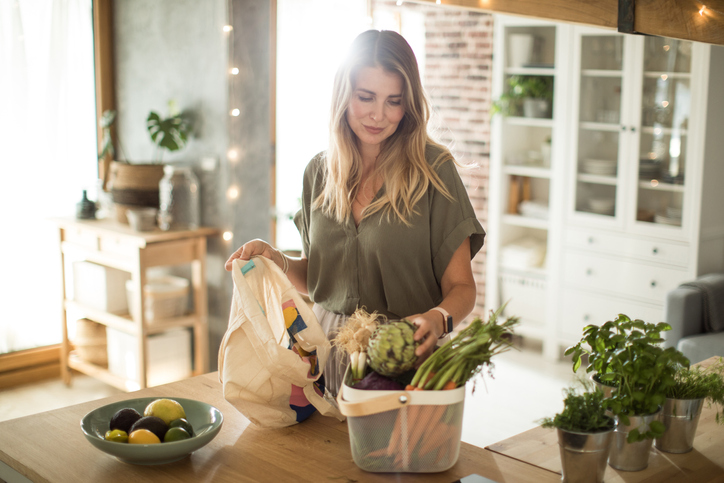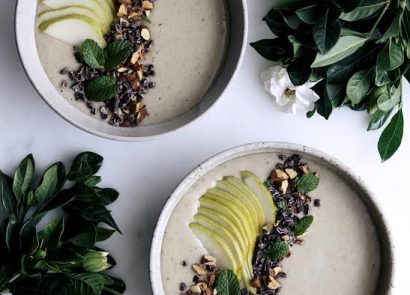Are you sure that you don’t want to finish that sandwich? One more bite? You might change your mind when you learn that the total food waste in the UK in 2020 weighed a shocking 4.5 million tons, according to The Guardian. We all know how easy it can be to serve ourselves too much food and have no other option but to throw it away, or buy too many ingredients and have no time to use them up before they go off. Luckily, there are lots of things you can do to curb wastefulness, many of which have the added benefit of making you healthier and reducing your carbon footprint. You don’t have to wait for Stop Food Waste Day, and you could even save a couple of pounds! Here are some of our favourite ways that you can save both your wallet and the world.
How much food is wasted in the UK?
So, just how bad is the problem here in the UK? We break down the food waste facts. Firstly, it’s important to say that the country has started to reduce food waste – according to the Waste and Resources Action Programme (WRAP), total food waste has dropped by the equivalent of seven percent per person over the past three years. This 4.5 million tons are comprised of food that could have been eaten, worth a staggering £14 billion. This amounts to £700 for an average family with children. While it’s true that the hospitality sector is a large contributor to these statistics, WRAP food waste data found that household food waste represented 70 percent of all food waste triggered after the food has been grown or produced, with potatoes being the single most wasted food.
Where does food waste go?
You may be wondering, ‘can you take food waste to the tip?’ – but what happens to food waste in this case? According to recyclenow.com, when food waste does end up in landfill sites, it rots and releases methane, a damaging greenhouse gas. So clearly this isn’t an ideal solution to the food waste problem. So is there such a thing as food waste recycling?
One solution is composting food waste – recyclenow.com reveals that almost half of the food waste found in the average rubbish bin could have been composted. Not only is home composting beneficial for the environment, it can also improve your soil and doing it for just one year can save global warming gases equivalent to all the CO2 your kettle produces annually, or your washing machine produces in three months! Setting it up isn’t tricky, but you must consider where you position it. It’s best to site it on soil, but if that’s not possible, you can place it on paving, decking, gravel or concrete, as long as you take precautions. Now that you’ve set up your bin, you can start adding to it. You should aim for a balance of 50 percent greens (such as weeds, grass mowings, tea leaves and veg peelings) and 50 percent browns (including autumn leaves, cardboard, nuts and wool) in your compost bin to get the right mix. There are certain things you should never put in a compost bin, including cat litter and olive oil, so be sure to check this out before you start. While the end result won’t look like the typical compost you can buy from a shop, you can use it around your garden, for example to feed your lawn or to enrich flower beds.
If you don’t have any outdoor space or simply think that making compost isn’t for you, there are other options available to help you get rid of food scraps in a more sustainable way. Many councils now offer food waste collection – you can use a kitchen food waste caddy or compostable food waste bags to keep your food waste separate from your main household waste bin, and it can be emptied into your compost bin or council food waste bin every couple of days.
Your council may recommend that you line your food waste caddy with a liner or newspaper. Only use liners that are recommended by your council, as some may not break down in the composting process.
However, you may find you get maggots in your food waste bin. While not very pleasant, there are steps you can take to reduce this issue. For example, ensure that you keep all of your bin lids closed, double bag all food scraps, keep bins out of direct sunlight and wash them regularly with boiling water.
Why do you need to reduce household food waste?
Global food waste is a huge issue for the planet. In fact, it has been estimated that if food waste was a country, it would be the third highest emitter of greenhouse gases after the USA and China, according to the Food and Agriculture Organization (FAO) of the United Nations. It makes for a sobering read, especially when you consider that one-third of greenhouse gas emissions globally come from agriculture, and 30 percent of the food we produce is wasted. If, as a planet, we stopped wasting food altogether, we’d eliminate eight percent of our total carbon emissions. In the face of all these food waste statistics, you may be thinking that there’s nothing you can do to fight food waste individually, but actually households can have a huge impact on reducing food waste and the issues it can lead to.
How can I reduce my food waste?
According to the latest research from Hotpoint, 81 percent of UK consumers are throwing away food each week. On average, they are binning 11 percent of their weekly shop, which comes out at around £9.44 worth of food – that’s a lot of money and food going to waste! Try these easy food waste solutions to reduce waste, from the way you do your weekly shop to the steps you take when cooking.
Buy ‘ugly food’
Ever discarded a cucumber at the supermarket because it looks a bit weird? Maybe it’s slightly bent, or has a black bit on it. Either way, it’ll still taste the same, so now’s the time to start putting that ugly fruit and veg in your basket – otherwise it will be tossed (and not into a salad). Want to try it for yourself? In a bid to reduce supermarket food waste, Asda now sells ‘wonky veg boxes’ which contain five kilos of fresh produce that doesn’t meet the grade for gracing the aisles, but is still perfectly edible. They cost £3.50, and are available at 550 stores across the UK. Plus, don’t forget to water your veg, as keeping them wet will help them stay fresh and crisp.
Learn the difference between ‘best-before’ and ‘use-by’
“There’s a lot of confusion around ‘display-until,’ ‘use-by,’ and ‘best-before’ dates and many people throw away food that is still perfectly good to eat,” say the experts at food waste app Too Good To Go. “Sell-by, display-until and best-before dates are all about quality. These are dates which the food retailer has estimated as the optimum time for the best taste and/or appearance for the product, meaning it’s still safe to eat the product past these dates. Use-by dates, however should be used strictly, as food past these dates is not safe to eat.”
Try root to stem cooking
Using the entire vegetable when cooking, including the roots, leaves and tops, can boost your nutrient intake and keep your bin empty. There are lots of creative ways to do this. Broccoli leaves, for example, are packed with vitamin A and an ounce of these greens can provide you with 90 percent of your recommended daily amount. Try chopping them finely and using them as a garnish or cooking them like spinach. Broccoli and cauliflower stems are also incredibly nutritious, containing more calcium, vitamin C and fibre than the actual florets. So by using them, not only do you avoid throwing half of the vegetable away, you’ll also boost your nutrient intake. And those carrot tops? Yep, you guessed it, you can use them too. Try making them into pesto or cooking them in a soup – they’re full of protein, minerals and vitamins. Did you know that you can also regrow lettuce leaves from your leftovers?
Make use of your freezer
“We’re all guilty of looking for a bargain when we’re shopping and it’s easy to get sucked into a two-for-one offer we don’t actually need,” say the experts at Too Good To Go. “That’s where the freezer can help out. Most foods can be frozen before the use-by date and then defrosted when needed – even milk, butter and grated cheese.” There are lots of reasons to buy frozen food too, including the fact that it can be more nutritious than fresh food, as it’s frozen so soon after being harvested.
But what foods are safe to freeze? Waitrose & Partners food editor, Alison Oakervee has some advice. “While it’s true that almost any food can be frozen safely, there are some things that freeze (and thaw) better than others. Leftovers or batch-cooked recipes that have lots of sauce such as stews, casseroles and bolognese, or a high proportion or liquid, like stocks and soups, freeze really well. As do assembled, part-cooked dishes such as lasagne, pastry or potato-topped pies. Avoid fresh fruit and vegetables that have a high water content, such as strawberries, melon, cucumber and lettuce, because they just go soft and mushy when thawed. And creams, yoghurts and egg-based sauces – such as mayonnaise – tend to separate and become watery, so avoid freezing those, but raw eggs freeze well when out of their shells and separated. Always cool food thoroughly first, then wrap it well to avoid freezer burn and freeze in regular flat shapes so things are easily stacked and in sensibly sized portions. Remember to add food labels and date everything – you might think you’ll recognise and remember what it is, but egg whites and apple puree can look surprisingly similar when frozen!”
Follow these quick tips to get the most from your freezer and help your food last longer:
- Milk and hard cheeses freeze well. If you have lots of small pieces of leftover cheese, grate them into a bag together, ready to make a cheese sauce when you need it.
- Freeze slices of bread and buns separately, to make portion control easier.
- Berries and bananas are great for the freezer and can act as a replacement for ice in smoothies.
Use the peel
It’s instinctive to dump peel, but you’re throwing away useful fibre, with orange peel boasting four times as much as the fruit itself, as well as vitamin C and antioxidants. Not convinced? Try using the zest in teas, baking, salads or stews. What about vegetables? Just like kale, you could turn your peelings into a tasty snack simply by tossing them in oil and baking them until crisp. Switching from a bag of ready salted crisps to this version will save around 70 calories and you’ll consume less fat and salt – sounds good!
Leftover food
“If there are leftovers after a meal, get creative in the kitchen and repurpose them,” say the experts at Too Good To Go. “Dice stale bread off-cuts to fry into croutons or blend into bread crumbs; have a go at turning leftover potatoes and vegetables into a hash to enjoy with eggs; or rustle up meringues from separated egg whites.” Want more tips on how to reuse your leftovers? Love Food Hate Waste recipes and advice will inspire – you can find lots of different ways to reboot your leftovers and make entirely different meals with them.
Always write a shopping list
We know it’s a dull bit of admin, but writing a shopping list before you get to the supermarket can help you save money and reduce food waste. You can check your cupboards and pantry before you go so you know exactly what you’ve already got, and make a list of meals for the week so you don’t end up buying a surplus of things you don’t need.
Make a meal plan
“Making a meal plan for the week and cooking in bulk is one way to prevent buying foods that may end up going to waste if not used in time,” say the experts at Too Good To Go. You could get ahead and meal prep good food too, following great meal prep tips – such as using your more perishable ingredients on Monday or Tuesday rather than the weekend, or roasting a bunch of vegetables on Sunday so that you have leftovers to quickly throw into salads, curries or wraps throughout the week. This will help to reduce plate waste too, as you can prepare smaller portion sizes in advance.
Check your food storage
Storing food correctly will ensure that it lasts longer. Make sure you know where things should be stored: for example, potatoes shouldn’t be kept in the fridge, as this reduces their shelf life, and you should keep bananas away from other fruit because the enzymes they produce can force other fruit to go mouldy faster. You could also make use of your ice cube trays by using them to freeze individual portions of herbs.
Go zero waste
Yes, this may sound challenging, but it really can be possible. Anne-Marie Bonneau, AKA Zero Waste Chef, has plenty of advice to go zero waste with her 14-day challenge, from hoarding glass jars to giving food away. Plus, have you thought about visiting a zero waste refill shop rather than your local supermarket? This is a great way to reduce your plastic waste as well as food waste, because you bring along your own containers and buy as much flour, sugar etc as you need, rather than having to stick to the pre-packaged amounts available in supermarkets.
What are the best food waste apps in the UK?
Of course, there are now a variety of apps available in the UK to help us all reduce our food waste. One of our favourites is the Olio food waste app. It’s a food-sharing social network that’s very easy to use. For example, if you’ve bought too many carrots and know you won’t be able to use them all before they go off, you can simply add them to the Olio app and someone in your local area can request to pick them up for free. It’s a simple idea, yet an ingenious one to help us reduce waste.
Another great app is Too Good To Go, which connects users to businesses that have excess food, so that this surplus food can be enjoyed instead of wasted. Users get delicious meals at a great price, businesses reach new customers and recover sunk costs, and the planet has less wasted food to deal with.
Other great apps include Karma, which is a London-based initiative that also connects users to businesses with extra food, Farmdrop, which connects users directly with local farmers, and Foodcloud, which partners supermarkets with charities to donate unsold food items.
Food waste recipes
From freezer-friendly recipes to tasty dishes that will transform your leftovers, we’ve got everything you need to help you decrease your food waste.
Veggie samosa pie
Serves: 4
Prepare: 25 mins + cooling + freezing
Cook: 15 mins + 1 hr 15 mins reheating
Ingredients
2 large potatoes (about 300g each), cut into 1cm cubes
250g frozen essential butternut squash
1 tbsp oil
2 onions, chopped
3 tbsp mild/medium curry paste (such as tikka)
150g frozen peas
5 sheets filo pastry
25g butter, melted
200g tzatziki, to serve
Beetroot salad, to serve
Method
- Boil the potatoes in salted water for 10 minutes. Add the squash, bring back to the boil and cook for another 5 minutes until the potatoes are tender. Drain when ready.
- Meanwhile, heat 1 tablespoon oil in a wide frying pan, then soften the onions for 10 minutes. Add the curry paste, cook for 1 minute, then add the potatoes, squash and peas, and gently stir. Season well, then cool.
- Lightly butter a sheet of filo, then use to line a shallow metal tin, about 27x13cm. Use 3 more sheets, alternating the overhang from the short end and the longest sides of the pan each time. Spoon in the filling, flatten, then top with the final sheet of buttered filo, folded to fit the top. Fold the overhanging edges back over in reverse order, then mark 8 triangles on the top with a sharp knife. Brush with the leftover butter. Cover with foil and freeze for up to 3 months.
- When ready to eat, preheat in the oven to 200C/400F/Gas 6. Bake with the foil on for 50-55 minutes, remove the foil and cook for a further 20 minutes or until piping hot, crisp and golden. Serve with spoonfuls of the tzatziki and the salad.
Leek and haddock pie with cheese saffron mash
Serves: 4
Prepare: 20 mins + cooling, freezing and defrosting
Cook: 15 mins + 40-50 mins reheating
Ingredients
50g butter, plus extra for greasing
2 leeks, sliced
425g frozen haddock fillets (or cod)
A pinch of saffron
600ml milk
40g essential plain flour
2 x 450g packs Cheddar Mash
Method
- Heat 35g butter in a large frying pan, add the leeks, season and soften for 5 minutes over a low heat. Sit the fish on top, sprinkle over the saffron, then add the milk. Bring to a simmer, then cover and cook for 5 minutes until the fish is just cooked. Lift the fish and leeks from the liquid with a slotted spoon, and put into a 25x20cm baking dish.
- Put the flour and remaining butter into the milk, then whisk constantly over a medium heat until boiling. Once thickened, cook for 1 minute. Taste for seasoning.
- Make sure the fish is in very big flakes, then pour the sauce over the fish and leeks, and leave until cold. Remove the mash from the containers, then cut each pack into 16 wedges and lay them on top of the pie. Cover with greased foil and freeze for up to 3 months.
- Defrost completely in the fridge. Preheat the oven to 200C/400F/Gas 6. Place the pie on a baking tray, remove the foil and bake for 40-50 minutes until piping hot, golden and bubbling.
Spiced sweet potato and lentil soup with chutney cheese twists
Serves: 4
Prepare: 20 mins + cooling and freezing
Cook: 20 mins + 25-30 mins reheating
Ingredients
2 tbsp garlic oil, plus extra to serve
2 onions, roughly chopped
2 tsp cumin seeds
Large pinch chilli flakes, plus extra to serve
2 sweet potatoes (about 750g), peeled and roughly chopped
200g split red lentils, rinsed
1.2 litres vegetable stock
320g chilled Jus-Rol All Butter Puff Pastry Sheet
2 tbsp Geeta’s Premium Mango Chutney
50g Wensleydale, well crumbled
Method
- Heat the garlic oil in a large saucepan, then soften the onions for 5 minutes. Add the cumin and chilli, cook for 2 minutes, then add the sweet potatoes, lentils and stock.
- Bring to a boil, then simmer for 5 minutes until the lentils are tender. Blend until smooth or mash and leave chunky. Season, then transfer to a freezer-proof, airtight container, cool completely and freeze for up to 3 months.
- Meanwhile, unroll the pastry with the longer side closest to you, then spread the mango chutney. Scatter the cheese on the right half of the pastry, then fold the other side over it. Press down a little, then cut into 8 strips starting from the folded edge. Twist the strips, then freeze on a baking tray. Once solid, pack into a freezer-proof container.
- Preheat the oven to 220C/425F/Gas 7. To reheat the soup, place it, frozen, in a large, deep frying pan with 50ml water, cover and cook over a low heat for 25-30 minutes, stirring occasionally until piping hot, adding a little water to loosen if needed. Meanwhile, bake the frozen twists on a parchment-lined baking tray for 15-18 minutes or until puffed and golden. Finish the soup with a drizzle more garlic oil and a few chilli flakes to serve.
Salted caramel and banoffee bread and butter pudding
Try making this deliciously indulgent salted caramel and banoffee bread and butter pudding for a weekend dinner party treat! Made from thick slices of leftover bread, you’ll impress your guests with this zero-waste classic.
This recipe is part of Hotpoint and Jamie Oliver’s Eat Your Fridge Challenge. The campaign is encouraging people to be more mindful when it comes to cooking, eating root to stem where possible and committing to throwing away zero edible food waste.
Ingredients
8 thick slices assorted leftover bread
1 tbsp granulated sugar
1 large overripe banana
2 tbsp demerara sugar
For the caramel:
125ml granulated sugar
60ml butter (if using salted, add slightly less salt)
¼ tsp flaky sea salt (or ⅛ tsp table salt, more to taste)
45ml double cream
For the custard:
350ml whole milk
50ml double cream
2 free-range eggs
Method
For the caramel:
- Take a bowl or plate and line with baking parchment. Place a small heavy bottomed saucepan on a medium heat. Add the sugar and watch it carefully as it melts. You don’t want to stir it around or it will crystallise, but you can occasionally tip the pan around to redistribute the sugar as it starts to melt.
- Once all the sugar has melted and is a lovely amber colour, remove from the heat and add in the butter, salt and cream. Stir well to incorporate and then place back on the heat and cook for another minute or so, to re-dissolve any sugar that hardened with the butter and take the caramel a shade darker.
- Pour the caramel into your lined bowl and place in the freezer to firm up.
- Once firm, remove from the freezer, turn out onto a board and cut the caramel into small squares.
For the custard:
- While the caramel is setting, make your custard.
- Gently warm the milk and cream in a pan over a low heat to scalding point. Don’t let it boil.
- Crack the eggs into a bowl, add the sugar and lightly whisk until pale.
- Add the warm milk and cream mixture and stir well, then strain the custard into a bowl.
To assemble:
- Take your leftover bread and slice it into thick slices or simply tear into chunks. Place a single layer of bread in a buttered pie dish, then dot with slices of banana and pieces of caramel. Repeat with the remaining bread, bananas and caramel until the dish is full.
- Pour the custard over the bread and gently press down to encourage it to all soak in. Leave in the fridge for 30 minutes or until you are ready to bake your pudding.
- Preheat the oven to 170C/325F/Gas 3. Sprinkle the pudding with the demerara sugar and bake until puffed and golden, about 30-40 minutes. You want the top to be golden but the pudding to still have a slight wobble in the middle.
- Serve with your favourite ice cream.
Jamie’s tips:
- You can use a mixture of seeded and white sourdough breads, but anything you have lying around will do.
- Stale croissants or pain au chocolat would make this even more indulgent.
- Try freezing those pesky odds and ends of old loaves and you’ll be surprised how quickly you find you have enough to make this.
- If making your own caramel seems scary, store-bought versions will work too – or simply swap it for a handful of chocolate chips.
Want more zero waste recipes? We’ve got you covered here, with everything from a speedy sausage and egg hash to the ultimate mac and cheese.






















